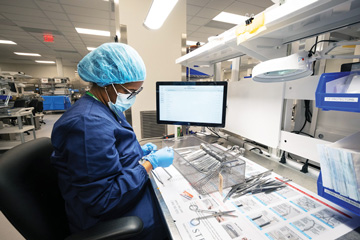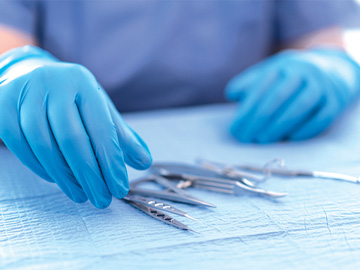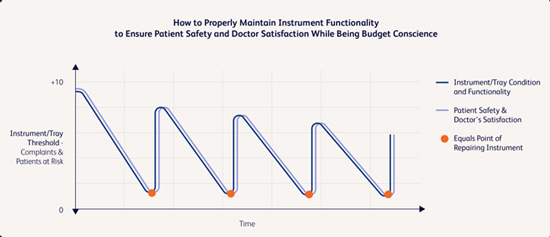Numerous current and developing tools are poised to boost reprocessing efficiency and quality.
 Northwell Health
Northwell Health
SCAN PLAN Near-field communication (NFC) tracking technology could further build on the power of existing RFID and barcode systems that enable reprocessing staff to better track instruments.
The technologies and solutions both available and in development for techs in today's sterile processing departments (SPDs) are becoming smarter, faster and more advanced every year, positively impacting the working quality and lifespan of surgical instruments while enhancing efficiency at high-volume facilities.
Here are some examples of cutting-edge SPD tools, technologies and future concepts that are exciting SPD leaders.
Even "smarter" instrument tracking. Edwin Martinez, a central sterile processing technician at MacNeal Hospital in Berwyn, Ill., envisions seamless integration of near-field communication (NFC) tracking technology into his SPD. NFC, which is used with hotel key cards and mobile phone payment apps, works at very close range to transfer information between two electronic devices in a contactless manner.
NFC is similar in concept to the radio frequency identification (RFID) and barcode scanning systems already used in some SPDs, enabling staff to know exactly where instrumentation and trays are in real time. Mr. Martinez believes NFC on staffers' personal devices can help make them even more situationally aware. "We already have wireless networks in hospitals, and we keep our phones close to or on us at all times in sterile processing," he says. "The technology is there, someone just needs to implement it in ways that could help us track single instruments, trays and surgical case carts with our phones."
Robotic instrument reprocessing. "My facility added robotic surgical services one year ago, and since the rollout, our sterile processing team has pivoted to learning and following stringent instructions for use (IFUs) for these devices while also working to maintain balanced production flow for the other surgical services our facility offers," says Rebecca Peplau, BS, CSPDT, CRCST, CER, sterile processing educator at Northern Light Mercy Hospital in Portland, Maine. "Due to capital equipment budget constraints, however, we're limited with what we can do since only one of our ultrasonic cleaners can accommodate robotic instrumentation. That leads to a backlog of items waiting to be run through the ultrasonic cleaning process."
"Ultrasonic machines that are specifically designed for robotic arm decontamination and disinfection are a key technology needed for today's frontline medical device reprocessing teams," says Monique Jelks, MSOL, BA, CRCST, area director of sterile processing at The Resource Group & Ascension Health for Indiana and Tennessee. These machines, while available, take up space and require significant capital investment, but they make sense for facilities that perform a high volume of robot-assisted surgeries. "With this type of technology, departments are able to clean and flush complex lumens and thermally disinfect robotic arms in the most efficient ways, creating high reliability and safe surgical care," she says.
AI, VR and AR. University of Louisville (Ky.) Health System Sterile Processing Department Manager Matthew Frederick, CRCST, believes a tidal wave of machine learning including artificial intelligence (AI), augmented reality (AR) and virtual reality (VR) will soon flow into SPDs, enhancing efficiencies and quality. For example, he foresees automated flushing pumps for manual cleaning, and software that identifies missing instruments from a tray with a single photo. He would love to see IFUs through AR glasses to ensure documented steps of reprocessing are accessible to techs whenever and wherever they need them, or AI being used to optimize surgical trays so facilities can better maintain inventory databases.
Mr. Frederick even envisions such innovation in the instruments themselves. "I believe that with more advances in the technology of imaging and 3D printers, our reprocessing teams may start printing single-use instruments instead of sterilizing reusable instruments, thus eliminating the potential for cross-contamination," he says.
"With the growing complexity of surgical procedures being performed in outpatient ORs, more forward-thinking facilities are turning their attention to high-tech reprocessing systems for their surgical instruments," says Hank Balch, CRCST, CER, CIS, CHL, founder and president of Beyond Clean, a clinical education company for sterile processing professionals. "It's more important than ever for facility leaders to have their fingers on the pulse of emerging technologies that improve the dangerous and dirty jobs done by hardworking techs in SPDs. It's no longer a question of if this equipment will be used, it's now a question of when. Will you be ready to invest in the latest platforms when that day arrives?"
.svg?sfvrsn=be606e78_3)




.svg?sfvrsn=56b2f850_5)